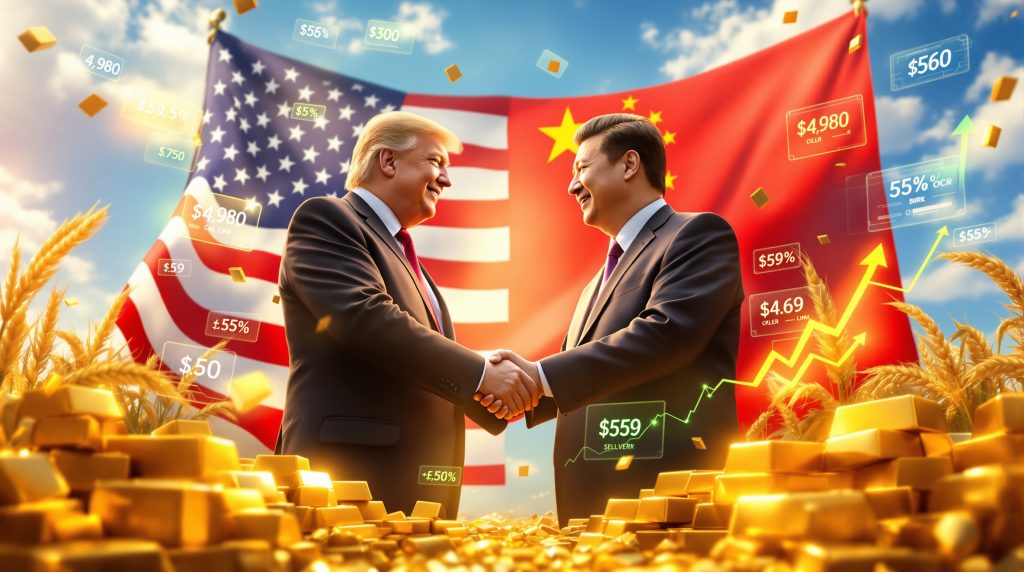Understanding the Recent US-China Trade Agreement
The diplomatic breakthrough between Washington and Beijing represents a significant shift in international trade dynamics. Following intensive negotiations in South Korea, both nations have agreed to implement substantial policy changes that could reshape global economic relationships for months to come.
The Trump and Xi trade truce emerged after what former President Trump described as an exceptional 90-minute meeting, which he rated as outstanding on his personal scale. This tactical pause in escalating tensions has provided immediate relief to businesses and investors who had grown weary of the unpredictable back-and-forth economic warfare that had characterised recent months.
Key Components of the Trade Agreement
The agreement encompasses several critical areas that had become flashpoints in the ongoing economic dispute. Furthermore, these components address both immediate concerns and longer-term strategic considerations between the two economic superpowers.
• Tariff Reductions: US import duties on Chinese goods decreased from 57% to 47%, representing a 10 percentage point reduction across affected categories
• Agricultural Commitments: China has agreed to resume purchasing American soybeans and agricultural products, though specific volume commitments remain undisclosed
• Rare Earth Cooperation: Beijing has committed to easing export restrictions on critical minerals for a 12-month period, providing temporary relief for technology manufacturers
• Fentanyl Enforcement: Enhanced Chinese cooperation on controlling synthetic drug shipments addresses a major concern for American policymakers
The temporary nature of many provisions suggests this represents a strategic pause rather than comprehensive resolution. The 12-month timeframe for rare earth cooperation particularly indicates both sides view this as breathing room for further negotiations rather than permanent settlement.
What Does This Trade Pause Mean for Investors?
The temporary cessation of trade hostilities has created mixed reactions across financial markets. While some sectors celebrate reduced uncertainty, others remain cautious about the durability of this diplomatic progress. However, this presents an opportunity for investors to reassess their investing strategy guide in light of these developments.
Market Response Analysis
Investment sentiment has shown measured optimism, with particular sectors benefiting more than others. Agricultural commodities experienced immediate gains following the announcement, as traders anticipated resumed Chinese purchases of American farm products. However, technology stocks faced continued uncertainty due to unresolved semiconductor restrictions that remain in place despite the broader agreement.
The Trump and Xi trade truce has provided psychological relief to markets that had grown accustomed to volatile policy announcements and retaliatory measures. Additionally, currency markets responded with reduced volatility, while commodity futures showed sector-specific movements based on the agreement's provisions.
Unresolved Issues Remain
Despite the positive developments, several critical areas lack concrete solutions. In addition, the Trump tariffs impact continues to influence market sentiment despite the temporary reprieve:
• Technology transfer disputes continue without clear resolution framework
• Intellectual property protections remain contentious between both nations
• Semiconductor export controls persist as major sticking point
• Strategic competition in emerging technologies shows no signs of abating
The April presidential visit to China represents the next major milestone for determining whether cooperation continues or tensions resume. This timeline creates ongoing uncertainty that investors must navigate carefully.
How Are Precious Metals Responding to Trade Developments?
Gold's performance following the trade announcement reflects the complex relationship between geopolitical stability and safe-haven demand. The yellow metal's recent price action demonstrates how quickly investor sentiment can shift based on diplomatic developments. For investors seeking detailed analysis, the current gold price forecast provides valuable insights into market trends.
Gold Price Movement Analysis
Recent trading sessions have shown gold recovering from a four-day decline, climbing back above $3,960 per ounce as markets digested the implications of reduced trade tensions. This recovery coincides with Federal Reserve policy decisions and evolving trade dynamics that continue influencing precious metals pricing.
Gold Performance Metrics:
| Timeframe | Price Movement | Key Drivers |
|---|---|---|
| Year-to-date | +50% | Central bank buying, geopolitical uncertainty |
| Recent high | $4,300/oz | Peak safe-haven demand |
| Current level | $3,960/oz | Trade truce impact, profit-taking |
The $4,381 record high achieved in October demonstrates the significant momentum precious metals have maintained throughout the year. Consequently, even as diplomatic developments create short-term volatility, the underlying trend remains robust.
Silver's Outperformance
Silver has demonstrated even stronger gains, climbing 62% year-to-date and reaching record levels of $54.50 per ounce. Industry experts project further upside potential, with forecasts suggesting $59 within twelve months, supported by both industrial demand growth and investment flows.
The white metal's performance reflects its dual nature as both industrial commodity and monetary asset. Furthermore, the gold‑silver ratio analysis reveals important dynamics between these precious metals that investors should consider.
What Role Are Central Banks Playing in Current Markets?
Central bank policies across major economies are diverging, creating unique opportunities and challenges for different asset classes. The coordination between monetary policy and trade developments will likely influence market direction in coming months.
Federal Reserve's Cautious Approach
The Fed's recent quarter-point rate cut came with tempered expectations for future reductions. Chair Powell's comments about December rate cuts being far from certain have influenced precious metals pricing and broader market sentiment. This cautious stance reflects the central bank's awareness that trade developments, while positive, may prove temporary.
The 4.75-5.00% federal funds rate range suggests monetary authorities remain prepared to adjust policy based on evolving economic conditions. However, this environment continues to support safe-haven assets that maintain their appeal during uncertain periods.
European Central Bank's Steady Course
The ECB's decision to maintain rates at 2% for three consecutive meetings reflects confidence in current economic conditions. This stability contrasts with the more volatile policy environment in other regions, as European inflation hovers near the bank's 2% target.
Central Bank Positioning Comparison:
| Central Bank | Current Rate | Recent Action | Forward Guidance |
|————–|—————|——————|
| Federal Reserve | 4.75-5.00% | -0.25% cut | Cautious on future cuts |
| European Central Bank | 2.00% | No change | Monitoring trade impacts |
| Other Major Banks | Varies | Mixed approaches | Data-dependent |
The ECB's eight rate cuts since mid-2024 brought deposit rates down from pandemic-era highs. Nevertheless, officials now appear content to pause and assess economic conditions rather than pursue additional accommodation.
Are We Witnessing Another Technology Bubble?
Historical parallels between current market conditions and previous speculative episodes are becoming increasingly apparent. The concentration of market value in specific technology companies raises questions about sustainable valuations and systemic risks.
Nvidia's Market Dominance
Current market capitalisation metrics show concerning parallels to previous bubble periods. Nvidia now represents over 16% of US GDP, a concentration level that exceeds Cisco's 3.9% peak during the dot-com bubble by more than 4x. This extreme concentration raises questions about market stability and diversification.
The mathematical comparison reveals the unprecedented nature of current technology valuations:
• Cisco's 2000 peak: 3.9% of US GDP
• Nvidia's current level: Over 16% of US GDP
• Concentration multiplier: More than 4x historical bubble peak
• Market cap trajectory: Racing toward $5 trillion valuation
This concentration risk has reached historically extreme levels. Consequently, it suggests potential vulnerability to market corrections that could ripple through broader financial markets.
SPAC Revival Signals
The return of Special Purpose Acquisition Companies provides another warning indicator of speculative excess. Market data shows 108 new SPAC launches in 2025, representing nearly double the 2024 total and raising over $24 billion since November.
Familiar figures from previous speculative periods have returned to the market. For instance, they're focusing on similar high-growth sectors:
• AI and artificial intelligence applications
• Cryptocurrency and digital finance
• Emerging technology platforms
• Digital transformation services
The playbook mirrors previous bubble periods: euphoria, concentration risk, and speculative excess targeting similar technology themes. These captured investor imagination during earlier market cycles.
What Are Industry Experts Predicting for Gold Prices?
Professional forecasts from the London Bullion Market Association's annual conference provide insight into precious metals outlook. These predictions come from industry participants who trade billions in bullion annually and possess deep market knowledge.
Professional Price Targets
Gold Forecast: Industry delegates project $4,980 per ounce by late 2026, representing a 27% increase from current levels. This forecast pushes the yellow metal within striking distance of the psychological $5,000 mark.
The forecast methodology is based on several structural factors. Furthermore, these considerations extend beyond temporary market movements to fundamental economic shifts:
• Central bank reserve diversification away from traditional assets
• Ongoing geopolitical uncertainties supporting safe-haven demand
• Monetary policy divergence across major economies
• Currency debasement concerns driving alternative store-of-value demand
Silver Projections: Experts anticipate $59 per ounce within 12 months, building on the current 62% year-to-date gains. This projection is supported by both industrial demand growth and investment flows.
Historical Context and Structural Shifts
Industry analysis reveals a fundamental change in global reserve management. For the first time in 30 years, gold has dethroned U.S. Treasuries as the primary reserve asset for global central banks. This represents a structural shift in how the world stores wealth rather than temporary market movement.
The implications extend beyond price appreciation to include several key factors. Moreover, these developments signal long-term changes in monetary system architecture:
• Portfolio rebalancing by institutional investors
• Supply constraint considerations as demand outpaces production
• Industrial applications growth particularly in technology sectors
• Monetary system evolution toward multi-polar reserve assets
How Should Investors Position for Ongoing Uncertainty?
The combination of temporary trade stability and underlying structural tensions creates a complex investment environment. Successful positioning requires understanding both immediate opportunities and longer-term risks that may emerge as agreements expire or conditions change.
Portfolio Diversification Strategies
Current market conditions suggest several key positioning approaches. The US‑China trade war impact continues to influence long-term strategic planning despite temporary truces:
Precious Metals Allocation: Consider gold and silver as portfolio insurance against both geopolitical uncertainty and monetary policy shifts. The Trump and Xi trade truce may provide temporary stability, but underlying tensions remain unresolved.
Geographic Diversification: Reduce concentration in single-market exposure by spreading investments across multiple regions and currencies. This strategy helps hedge against policy reversals or economic disruptions.
Sector Balance: Avoid overweighting in bubble-prone technology sectors where valuations have reached extreme levels. This approach maintains balance compared to historical norms and economic fundamentals.
Risk Management Considerations
The current environment demands heightened attention to multiple risk factors. In addition, investors must prepare for various scenarios that could unfold:
• Concentration risk in individual holdings, particularly technology stocks
• Currency exposure across international positions as trade policies evolve
• Liquidity requirements during potential market stress periods
• Policy reversal risks when temporary agreements expire
Professional investors are implementing defensive strategies while maintaining exposure to growth opportunities. They balance the need for protection against the potential for continued market advancement.
What Happens After the Trade Truce Period?
The temporary nature of current agreements means investors must prepare for potential policy reversals. April's planned presidential visit to China will likely determine whether cooperation continues or tensions resume. This creates a critical inflection point for global markets.
Scenario Planning Framework
Optimistic Outcome: Extended cooperation leading to comprehensive trade agreement could reduce safe-haven demand temporarily. However, it would support global economic growth and risk asset performance simultaneously.
Base Case: Continued tactical pauses with periodic tension episodes maintain current uncertainty levels. This scenario supports precious metals demand while creating volatile trading conditions across asset classes.
Pessimistic Scenario: Return to escalating trade conflicts and market volatility would likely drive significant safe-haven flows. Consequently, this would benefit gold and silver while pressuring risk assets and global growth prospects.
Investment Implications by Scenario
Each potential outcome carries different implications for asset allocation and risk management strategies. Furthermore, understanding these scenarios helps in developing robust investment frameworks:
Under Extended Cooperation:
• Reduced safe-haven premium in precious metals pricing
• Improved prospects for international equities and trade-sensitive sectors
• Currency stabilisation reducing hedging requirements
During Continued Uncertainty:
• Sustained precious metals demand as portfolio insurance
• Preference for domestic over international investments
• Emphasis on liquid, easily tradeable assets
Upon Conflict Resumption:
• Significant safe-haven flows into gold and silver
• Currency volatility requiring active hedging strategies
• Defensive positioning across multiple asset classes
Precious metals may provide stability across multiple scenarios due to their safe-haven characteristics. Additionally, central bank adoption trends appear structural rather than cyclical.
Technology Sector Vulnerabilities and Market Implications
Beyond the immediate trade negotiations, technology sector concentration presents systemic risks that could influence broader market stability. The extreme valuation metrics seen in artificial intelligence companies mirror historical bubble conditions. Moreover, these conditions present potentially severe correction risks.
Comparative Bubble Analysis
Historical analysis reveals striking similarities between current conditions and previous speculative episodes. According to Reuters analysis, the tactical nature of current agreements parallels temporary solutions from previous economic conflicts:
2000 Dot-Com Peak Characteristics:
• Single company representing 3.9% of GDP (Cisco)
• Widespread speculative investment vehicles (day trading, IPO mania)
• Focus on revolutionary technology transformation
• Extreme valuation multiples divorced from fundamentals
2025 AI Bubble Indicators:
• Single company exceeding 16% of GDP (Nvidia)
• SPAC revival with 108 launches raising $24+ billion
• Artificial intelligence transformation narrative
• Valuations reaching historically unprecedented levels
The mathematical progression suggests current conditions exceed previous bubble extremes by significant margins. Consequently, this potentially indicates larger correction risks when speculative excess unwinds.
Safe-Haven Asset Positioning
Historical precedent suggests that when technology bubbles deflate, capital flows toward traditional safe-haven assets accelerate rapidly. Gold's performance during the 2000-2002 technology correction provides insight into potential precious metals behaviour during similar future episodes.
During the dot-com collapse, several key patterns emerged. For instance, these historical precedents offer guidance for current positioning strategies:
• NASDAQ declined over 78% from peak to trough
• Gold advanced significantly as safe-haven demand surged
• Central banks increased precious metals allocations
• Investors sought alternatives to equity concentration
Current positioning suggests similar dynamics could unfold if technology valuations correct meaningfully from current elevated levels.
Central Bank Reserve Transformation and Long-Term Implications
The structural shift in central bank reserve preferences represents one of the most significant monetary developments in decades. This transformation extends beyond temporary market movements to fundamental changes in how sovereign wealth is stored and managed globally.
Historical Reserve Evolution
For three decades, U.S. Treasuries dominated central bank reserve portfolios based on several factors. However, recent developments have challenged this traditional framework:
• Liquidity advantages in deep, transparent Treasury markets
• Political stability of U.S. government backing
• Currency dominance of dollar in international trade
• Interest income generation from Treasury yields
The recent shift toward gold challenges these traditional advantages. Furthermore, it suggests fundamental changes in how central banks evaluate reserve asset characteristics.
Drivers of Reserve Diversification
Several factors contribute to central banks' increasing gold allocation. Bloomberg reports indicate that this diversification reflects broader geopolitical realignment:
Geopolitical Risk Management: Tensions between major powers create incentives for reserve diversification away from any single country's assets. This occurs regardless of historical stability or liquidity characteristics.
Monetary Policy Concerns: Extended periods of low interest rates and quantitative easing programmes raise questions. These concerns focus on long-term currency purchasing power and debt sustainability.
Sanctions Risk: Recent use of financial system access as policy tool creates demand for assets outside traditional banking systems. Moreover, this trend continues to influence central bank decision-making.
Portfolio Theory Application: Modern portfolio management principles support diversification across asset classes. This includes assets with different risk and return characteristics from government bonds.
Long-Term Market Implications
This structural shift suggests sustained support for precious metals pricing independent of short-term trade negotiations or economic cycles:
• Consistent demand from institutional buyers with long investment horizons
• Price floor effects from central bank accumulation during market weakness
• Reduced correlation with traditional financial assets during stress periods
• Supply constraint amplification as official sector demand competes with private investment
The Trump and Xi trade truce may provide temporary relief from geopolitical tensions. However, underlying structural factors supporting central bank gold demand appear likely to persist regardless of specific bilateral relationships.
Investment Strategy Framework for Multiple Scenarios
Given the complexity of current market conditions, successful investment strategies require flexibility to adapt to rapidly changing circumstances. Additionally, they must maintain core positioning for longer-term structural trends.
Core Portfolio Components
Precious Metals Foundation: Maintain 5-15% allocation to physical gold and silver as portfolio insurance against multiple risk scenarios. These include policy reversals, bubble corrections, and currency debasement.
Geographic Distribution: Spread investments across U.S., European, and Asian markets to reduce dependency on any single economy or policy regime. Furthermore, maintain currency hedging for non-domestic positions.
Sector Diversification: Balance technology exposure with traditional value sectors, utilities, energy, and consumer staples. This approach helps avoid concentration in bubble-prone areas while maintaining growth participation.
Liquidity Management: Maintain higher cash positions than normal to capitalise on opportunities during potential market dislocations. This strategy also provides flexibility during policy-driven volatility periods.
Dynamic Adjustment Protocols
Trade Negotiation Monitoring: Track developments in U.S.-China relationships beyond the current truce period. Pay particular attention to the April 2026 presidential visit timeline and policy implementation details.
Bubble Indicator Tracking: Monitor technology sector concentration metrics, SPAC issuance patterns, and valuation multiples. These indicators help identify signs of speculative peak or early correction phases.
Central Bank Activity: Follow official sector gold purchases, reserve composition changes, and policy statements regarding asset allocation preferences. This monitoring confirms structural trends.
Economic Data Integration: Incorporate inflation data, employment statistics, and GDP growth figures to assess sustainability. This analysis determines whether current policies and market conditions remain viable over extended periods.
Risk Management Implementation
Professional risk management requires systematic approaches to position sizing and downside protection. However, these protocols must remain flexible enough to adapt to changing conditions:
Position Limits: Restrict individual holdings to maximum 5% of portfolio to prevent concentration risk. Make exceptions only for diversified index funds or ETFs.
Correlation Monitoring: Regularly assess correlations between portfolio components to ensure diversification benefits remain effective. This becomes particularly important during stress periods.
Rebalancing Triggers: Implement systematic rebalancing when asset class weightings deviate more than 25% from target allocations. This maintains intended risk profile throughout market cycles.
Stress Testing: Quarterly portfolio stress tests using scenarios based on previous bubble corrections, trade war escalations, and financial crises. These tests validate portfolio resilience under adverse conditions.
The Trump and Xi trade truce represents a pause rather than a permanent resolution in evolving global economic relationships. While markets have responded positively to reduced immediate tensions, underlying structural issues remain unaddressed. Consequently, this creates ongoing uncertainty that favours flexible, well-diversified investment approaches.
Investment decisions should be based on individual circumstances and risk tolerance. This analysis is for educational purposes and does not constitute personalised investment advice. Precious metals investments carry risks including price volatility and potential losses.
Ready to Capitalise on Major Trade Developments?
Discovery Alert's proprietary Discovery IQ model delivers real-time alerts on significant ASX mineral discoveries, helping investors identify actionable opportunities that could benefit from shifting global trade dynamics and precious metals demand. Begin your 30-day free trial today to position yourself ahead of the market with instant notifications powered by advanced AI technology.




